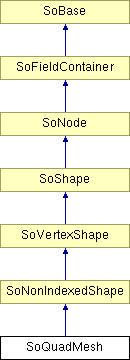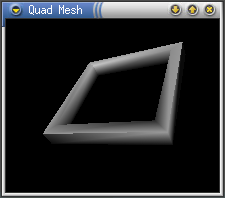
#include <Inventor/nodes/SoQuadMesh.h>
Inheritance diagram for SoQuadMesh::

Public Methods | |
| SoQuadMesh (void) | |
| virtual void | GLRender (SoGLRenderAction *action) |
| virtual void | getPrimitiveCount (SoGetPrimitiveCountAction *action) |
| virtual SbBool | generateDefaultNormals (SoState *state, SoNormalBundle *nb) |
Static Public Methods | |
| void | initClass (void) |
Public Attributes | |
| SoSFInt32 | verticesPerColumn |
| SoSFInt32 | verticesPerRow |
Protected Methods | |
| virtual | ~SoQuadMesh () |
| virtual void | generatePrimitives (SoAction *action) |
| virtual void | computeBBox (SoAction *action, SbBox3f &box, SbVec3f ¢er) |
| virtual SbBool | generateDefaultNormals (SoState *, SoNormalCache *) |
This node uses the coordinates in order, either from the state or from the SoQuadMesh::vertexProperty node, to construct a quadrilateral mesh.
The quads are generated in row major order, using the two fields SoQuadMesh::verticesPerColumn and SoQuadMesh::verticesPerRow to specify the mesh. E.g. if SoQuadMesh::verticesPerColumn is 3 and SoQuadMesh::verticesPerRow is 2, two quads will be generated with the first one using (in order) coordinates 0, 1, 3 and 2, the second one using coordinates 2, 3, 5 and 4 (you get three rows of vertices; the first row uses vertices 0 and 1, the second row 2 and 3, and the third row 4 and 5).
Here's a quick and simple usage example code snippet:
// Vertices for the Quad mesh.
static float vertices[25][3] = {
// Row 1
{-11, 0, 1}, {0, 11, 1}, {11, 0, 1}, {0, -11, 1}, {-11, 0, 1},
// Row 2
{-9, 0, 1}, {0, 9, 1}, {9, 0, 1}, {0, -9, 1}, {-9, 0, 1},
// Row 3
{-9, 0, -1}, {0, 9, -1}, {9, 0, -1}, {0, -9, -1}, {-9, 0, -1},
// Row 4
{-11, 0, -1}, {0, 11, -1}, {11, 0, -1}, {0, -11, -1}, {-11, 0, -1},
// Row 5
{-11, 0, 1}, {0, 11, 1}, {11, 0, 1}, {0, -11, 1}, {-11, 0, 1}
};
// This function generate an object by using the SoQuadMesh node
// Return:
// SoSeparator *
static SoSeparator *
quadMesh(void)
{
SoSeparator * qm = new SoSeparator;
// Define coordinates
SoCoordinate3 * coords = new SoCoordinate3;
coords->point.setValues(0, 30, vertices);
qm->addChild(coords);
// QuadMesh
SoQuadMesh * mesh = new SoQuadMesh;
mesh->verticesPerRow = 5;
mesh->verticesPerColumn = 5;
qm->addChild(mesh);
return qm;
}
The quadmesh geometry resulting from this code looks like this:

For SoQuadMesh, normals and materials can be bound PER_PART (per row), PER_FACE, PER_VERTEX and OVERALL. The default material binding is OVERALL. The default normal binding is PER_VERTEX.
|
|
Constructor. |
|
|
Destructor. |
|
|
Sets up initialization for data common to all instances of this class, like submitting necessary information to the Coin type system. Reimplemented from SoNonIndexedShape. |
|
|
Action method for the SoGLRenderAction. This is called during rendering traversals. Nodes influencing the rendering state in any way or who wants to throw geometry primitives at OpenGL overrides this method. Reimplemented from SoShape. |
|
|
Action method for the SoGetPrimitiveCountAction. Calculates the number of triangle, line segment and point primitives for the node and adds these to the counters of the action. Nodes influencing how geometry nodes calculates their primitive count also overrides this method to change the relevant state variables. Reimplemented from SoShape. |
|
|||||||||||||||
|
Subclasses should overload this method to generate default normals using the SoNormalBundle class. TRUE should be returned if normals were generated, FALSE otherwise. Default method returns FALSE. Reimplemented from SoVertexShape. |
|
|
For internal use only. Reimplemented from SoShape. |
|
||||||||||||||||||||||
|
For internal use only. Reimplemented from SoShape. |
|
|||||||||||||||
|
Subclasses should overload this method to generate default normals using the SoNormalCache class. This is more effective than using SoNormalGenerator. Return TRUE if normals were generated, FALSE otherwise. Default method just returns FALSE. This method is not part of the original OIV API. Do not overload it if you intend to create a node that can be used on both Coin and OIV. Reimplemented from SoVertexShape. |
|
|
Specifies to number of vertices in each column. |
|
|
Specifies the number of vertices in each row. |
 1.2.9 written by Dimitri van Heesch,
© 1997-2001
1.2.9 written by Dimitri van Heesch,
© 1997-2001